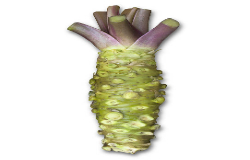Wasabi Nutrition facts
Wasabi

Wasabi root is one of the traditional accompaniments to prepare several dishes unique to the Japanese cuisine. If you have visited a Japanese sushi bar, you most likely be served an eye-catching, light green condiment paste that when consumed would result in feeling like a gush of volcano eruption hitting through the nasal passages sending your olfactory senses wobbling!
It is a small, perennial plant in the Cruciferous (brassica) or mustard of family plants native to the Japan. Some of the close relatives of this root in the same family are mustard, horseradish, cabbage, cauliflower, etc.
Scientific name: Wasabia japonica.
Wasabi is a small herb growing about 2 feet tall from the soil surface and features broad, heart-shaped leaves. Its cultivation necessitates suitable soil and environmental conditions to flourish. Only a few geographical areas are suited for its growth. In the wild, it grows near natural springs flowing through wooded forest areas. Fed by clear Abe river streams flooding the mountain terraces, Utougi in Shizuoka prefecture in Japan considered the perfect place for its cultivation.
| Nutrition Principle | Nutrition Value | Percentage of RDA |
|---|---|---|
| Principle | ||
| Energy | 109 cal | 5.5% |
| Carbohydrates | 23.54 g | 18% |
| Protein | 4.80 g | 8.5% |
| Total Fat | 0.63 g | 3% |
| Cholesterol | 0 mg | 0% |
| Dietary Fiber | 23.54 g | 62% |
| Vitamins | ||
| Folates | 18 µg | 4.5% |
| Niacin | 0.743 mg | 4.5% |
| Pantothenic acid | 0.203 mg | 4% |
| Pyridoxine | 0.274 mg | 21% |
| Riboflavin | 0.114 mg | 9% |
| Thiamin | 0.131 mg | 11% |
| Vitamin A | 35 IU | 1% |
| Vitamin C | 41.9 mg | 70% |
| Electrolytes | ||
| Sodium | 17 mg | 1% |
| Potassium | 568 mg | 12% |
| Minerals | ||
| Calcium | 128 mg | 13% |
| Copper | 0.155 mg | 17% |
| Iron | 1.03 mg | 13% |
| Magnesium | 69 mg | 17% |
| Manganese | 0.126 mg | 5% |
| Phosphorus | 80 mg | 11% |
| Zinc | 1.62 mg | 15% |
| Phyto-nutrients | ||
| Carotene-ß | 21 µg | -- |
| Crypto-xanthin-ß | 0 µg | -- |
| Lutein-zeaxanthin | 0 µg | -- |